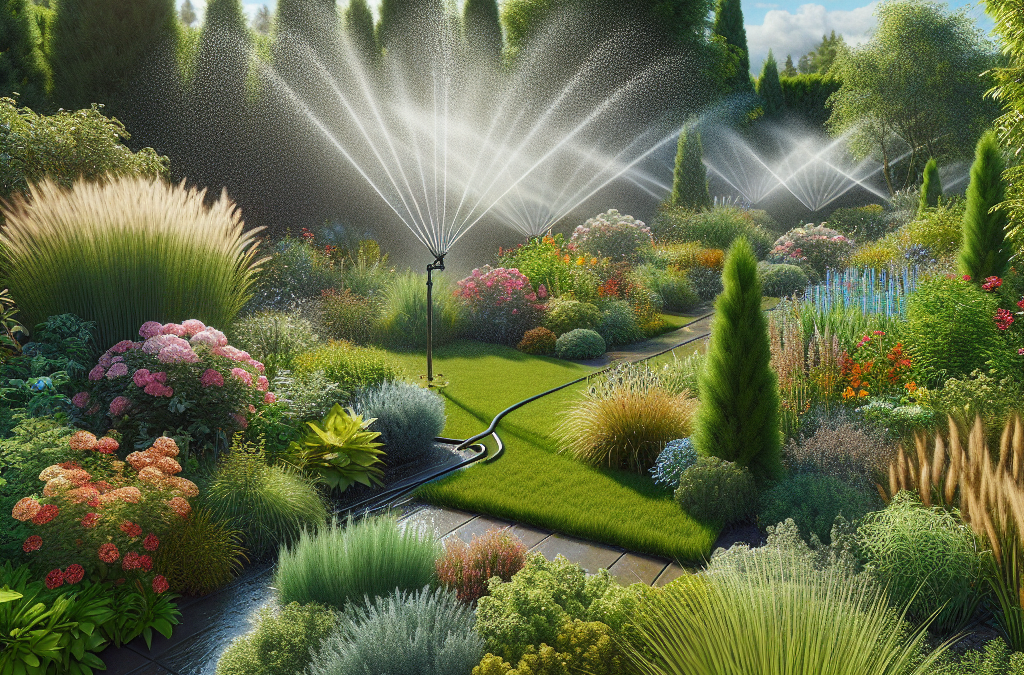Portland’s unique climate, characterized by its mild, wet winters and dry summers, presents both opportunities and challenges for maintaining a lush, green landscape. An efficient irrigation system is crucial for ensuring that your garden and lawn receive the optimal amount of water throughout the year. Whether you’re a homeowner looking to enhance your curb appeal or a business aiming to create an inviting outdoor space, understanding the basics of irrigation systems is the first step.
Installing a well-designed irrigation system can lead to significant water savings, healthier plants, and a more sustainable landscape. In this guide, we’ll delve into the intricacies of Portland irrigation system installation, from planning and selecting the right type of system to the benefits and maintenance tips. By the end of this article, you’ll have a comprehensive understanding of how to effectively manage your property’s water needs.
*Contact us today to discover how our landscaping services can transform your property!* https://yardservicepdx.com
Benefits of Proper Irrigation System
Investing in a proper irrigation system offers a multitude of benefits that go beyond mere convenience. One of the most significant advantages is water efficiency. An automated irrigation system can be programmed to water your landscape at optimal times, reducing water waste and ensuring that plants receive adequate hydration. This not only conserves water but also lowers your utility bills.
Moreover, a well-planned irrigation system promotes healthier plant growth. Consistent watering schedules help maintain the right moisture levels in the soil, preventing both under and over-watering. This leads to lush, vibrant lawns and gardens that are more resistant to diseases and pests.
Another critical benefit is time savings. With an automated system, you no longer need to spend hours manually watering your garden. This frees up your time for other activities and ensures that your landscape is taken care of even when you’re away.
Proper irrigation systems also contribute to soil health. By delivering water directly to the root zone, they minimize soil erosion and nutrient runoff, which can degrade soil quality over time. Additionally, features like rain sensors and soil moisture detectors ensure that your landscape is watered only when necessary, further enhancing soil preservation.
Overall, a well-installed irrigation system is an investment in the long-term health and beauty of your landscape, making it a crucial component of any landscaping project in Portland.
Types of Irrigation Systems

When considering Portland irrigation system installation, it’s essential to understand the different types of irrigation systems available to make an informed decision. Each type has its unique advantages and is suited to specific needs and landscape types.
Sprinkler systems are perhaps the most common and are ideal for covering large areas like lawns. These systems use a network of pipes and sprinkler heads to distribute water evenly across the landscape. They can be easily adjusted for different water pressures and coverage areas, making them versatile and efficient.
For gardens and flower beds, drip irrigation systems are highly efficient. These systems deliver water directly to the base of the plants through a series of tubes and emitters. By targeting the root zone, drip irrigation minimizes water wastage and reduces the risk of weed growth. This method is particularly beneficial for conserving water and ensuring that plants receive a consistent moisture supply.
Soaker hoses are another type of irrigation system that works well for garden beds and row plantings. These hoses are porous and allow water to seep out slowly, providing a gentle and even watering. They are easy to install and can be laid out to follow the contours of your landscape, making them a flexible option for various garden layouts.
Finally, rotary systems are designed for larger landscapes or areas with uneven terrain. These systems use rotating sprinkler heads that cover a wide radius, ensuring even water distribution over large areas. They are particularly effective for watering slopes and irregularly shaped lawns.
Understanding the different types of irrigation systems can help you choose the best option for your landscape, ensuring efficient water use and optimal plant health.
Planning Your Irrigation System

Proper planning is crucial for a successful Portland irrigation system installation. A well-thought-out plan ensures that your landscape receives the right amount of water, optimizing plant health and conserving resources. Here’s what you need to consider:
First, assess your landscape. Take note of the different areas, such as lawns, garden beds, trees, and shrubs. Each of these areas may have different watering needs, so understanding your landscape layout is essential. Create a detailed map that includes all the zones you intend to irrigate.
Next, determine the water requirements for each zone. Consider the type of plants, soil conditions, and sun exposure. For example, lawns generally need more water than drought-tolerant shrubs, and areas with full sun will require more frequent watering than shaded regions. This step helps you tailor the irrigation system to meet specific needs, avoiding over- or under-watering.
Water pressure and flow rate are also critical factors. Measure your property’s water pressure and calculate the flow rate to ensure your system can operate efficiently. If the pressure is too low, you may need to install a booster pump, while high pressure might require a pressure regulator.
Choosing the right type of irrigation system for each zone is the next step. As discussed, options include sprinkler systems, drip irrigation, soaker hoses, and rotary systems. Select the system that best fits the specific needs of each area in your landscape.
Lastly, consider automation and control. Modern irrigation systems can be equipped with timers, sensors, and smart controllers that adjust watering schedules based on weather conditions and soil moisture levels. Automation not only saves time but also ensures efficient water use.
By carefully planning your irrigation system, you can create a sustainable and effective watering solution that keeps your landscape thriving while conserving water and reducing maintenance efforts.
Installation Process Step-by-Step

Once you’ve meticulously planned your Portland irrigation system installation, it’s time to move on to the actual installation process. Follow these step-by-step instructions to ensure a seamless setup:
1. Gather Materials and Tools: Before you begin, assemble all the necessary materials and tools. This includes pipes, fittings, sprinkler heads, drip lines, timers, shovels, trenchers, and any other equipment specified in your plan.
2. Mark the Layout: Use flags or stakes to mark the locations of sprinklers, emitters, and other components based on your landscape map. This visual guide helps you stay organized and ensures accurate placement.
3. Dig Trenches: Dig trenches for the main water lines and lateral lines. The depth of the trenches should accommodate the pipes while ensuring they are below the frost line to prevent freezing during colder months. Typically, trenches should be 6-12 inches deep.
4. Lay Pipes and Connect Components: Begin laying the main water line in the trenches, followed by the lateral lines. Use appropriate fittings to connect pipes, ensuring they are securely attached to prevent leaks. Install the sprinkler heads, drip emitters, or soaker hoses as planned, making sure they are level with the ground for even water distribution.
5. Install Valves and Backflow Preventer: Install zone valves to control the flow of water to different areas of your landscape. Additionally, a backflow preventer is essential to protect your water supply from contamination. Follow local regulations to ensure proper installation.
6. Connect to Water Source: Attach the irrigation system to your main water supply. This step may require professional assistance to ensure compliance with plumbing codes and to avoid potential issues.
7. Test the System: Turn on the water and test the entire system. Check for leaks, ensure all components are working correctly, and adjust sprinkler heads or emitters for optimal coverage. Make necessary adjustments to water pressure and flow rate if needed.
8. Backfill Trenches: After confirming that the system operates smoothly, backfill the trenches with soil, ensuring that pipes and components are securely buried. Compact the soil to avoid future settling.
9. Program the Controller: Set up the irrigation controller according to your watering schedule. Modern controllers allow you to customize watering times, durations, and frequencies for different zones, ensuring efficient water use.
By following these steps, you can achieve a successful irrigation system installation that keeps your landscape healthy and vibrant while conserving water and minimizing maintenance.
Maintenance and Troubleshooting Tips

Maintaining your Portland irrigation system is crucial to ensure its longevity and optimal performance. Regular maintenance helps prevent issues that can lead to water waste and landscape damage. Here are some essential maintenance and troubleshooting tips for your irrigation system:
1. Regular Inspections: Conduct routine inspections of your irrigation system. Check for leaks, broken sprinkler heads, clogged emitters, and any other visible damage. Addressing these issues promptly can save water and prevent larger problems down the line.
2. Clean Filters and Nozzles: Over time, filters and nozzles can become clogged with dirt and debris. Clean these components regularly to ensure efficient water flow and even distribution. Replace any parts that are excessively worn or damaged.
3. Adjust Sprinkler Heads: Make sure sprinkler heads are properly aligned and adjusted. They should provide even coverage without overspraying onto sidewalks, driveways, or buildings. Periodically check for misalignment caused by lawn mowers or foot traffic.
4. Seasonal Adjustments: Adjust your irrigation schedule according to the season. In Portland, this means reducing watering times during the rainy season and increasing them during dry periods. Modern controllers often have seasonal adjustment features to make this process easier.
5. Winterization: Before the onset of freezing temperatures, winterize your irrigation system to prevent damage. This involves draining the system of water and blowing out any remaining water with compressed air. Proper winterization protects your pipes and components from freezing and cracking.
6. Monitor Water Pressure: High water pressure can damage your irrigation system, while low pressure can reduce its efficiency. Use a pressure gauge to monitor and adjust the water pressure as needed. Installing a pressure regulator can help maintain consistent pressure levels.
7. Troubleshoot Common Issues: If you notice dry spots, pooling water, or uneven coverage, it’s time to troubleshoot. Check for clogged nozzles, broken pipes, or malfunctioning valves. Address these issues promptly to ensure your landscape receives the right amount of water.
8. Keep Records: Maintain a log of your irrigation system’s maintenance activities, including inspections, repairs, and adjustments. This can help you track performance over time and identify recurring issues that may need professional attention.
By following these maintenance and troubleshooting tips, you can ensure your irrigation system operates efficiently and effectively, providing your landscape with the water it needs to thrive. Contact us today to discover how our landscaping services can transform your property!

